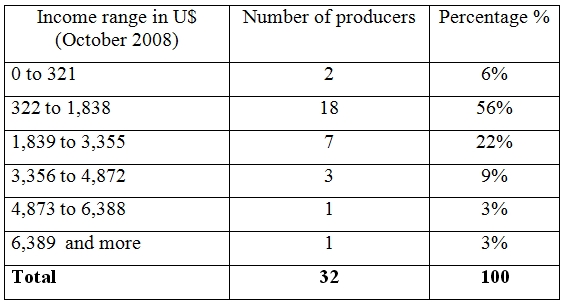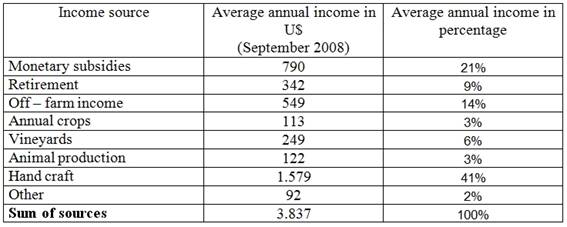Source of income
The productive systems in the area are mainly composed by extensive animal production based on natural pasture, annual crops and forestry plantations. In the case of medium and large scale producers, the whole production is sold in the market. However, no study exists to identify the source of income of the families in these categories. In the case of small holder, a study performed for a specific county in the VIII Region, Ninhue, allows us to make a characterization of the income sources of this segment of producer. Ninhue is a county located in the interior dryland of the VIII Region and represents a good example for a case study on productive system and income sources. In this study, INIA interview 32 producers of the Ninhue area in the year 2003, and the main results are summarized below (INIA, 2003).
The sample used indicated that the average size of the farms is 8.7 hectares, with a standard deviation of 11.4 hectares. Therefore the size is consistent with the size of a subsistence or small holder farm of the spot area. The average annual income for the sample was U$ 3.414 (Table 8). As a reference the minimum income established by law is U$ 3.283. According to the table, we expect that around 50% of the sample would have an income higher than the minimum wage.

Table 8: Income level of 32 farmers from Ninhue county, VIII Region. Data were transformed into dollars of October 2008 using the Consumer Price Index variation between 2003 and 2008 (22.4%), and the average exchange rate for October 2008.
Handcraft sales was the most relevant source of income for the group providing around 40% of the returns (Table 9). However, it is important to mention, that this county has a tradition on handcraft, and this is not the reality of all the area. Nevertheless, we expect that the other sources of income mentioned in Table 9 could be extrapolated to the whole study site area. Subsidies, off- farm and retirement income were the most relevant income sources after handcraft sales, indicating a high dependency of this group on social shelter and outside jobs. In many cases, this are temporarily jobs, for which the worker is absent during a few month, returning for the most labour intensive period in the farm. In addition, it can be said that 90% of the study group received some kind of subsidy, while only 38% had an outside job. The study did not consider self consumption as income. The analysis was performed on cash entries.

Table 9: Income sources of 32 farmers from Ninhue county, VIII Region.
The most relevant items of expenditure in this group were food (Table 10). In the study the expenditure generated by the productive activities was included in the list of items, since in general producers do not consider them apart. This item represents almost 25% of the total.

Table 10: Total annual expenditure of 32 farmers from Ninhue county, VIII Region.
In summary, the study reveals that the segment of subsistence and small holder has a very low capacity for investment. The income they generate is barely enough to buy the minimum a family needs to live. On the other side, most of the income is derived from activities not related to the farm, which gives an indication of the low level of productivity and profitability of the land.